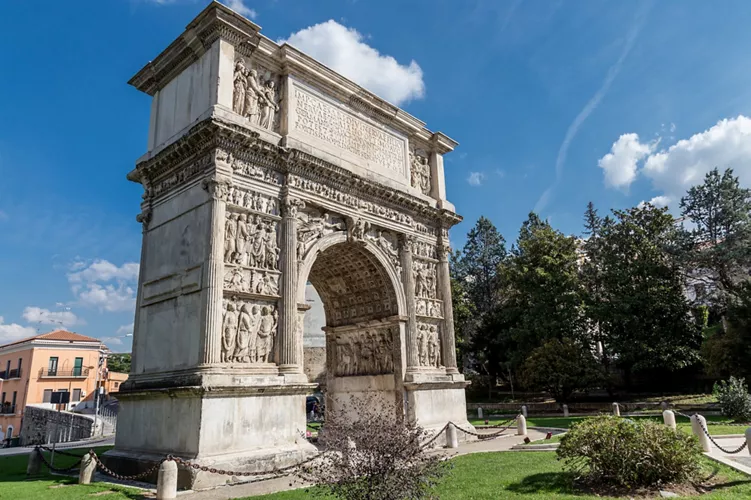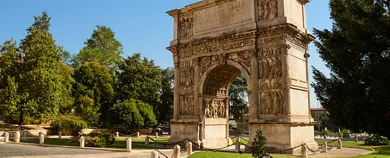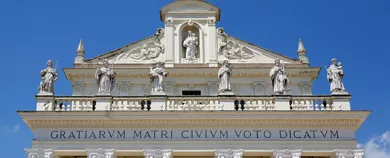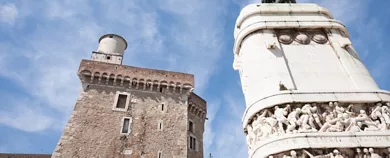This content was automatically translated. View the original text.




Overview
The Arch of Trajan in Benevento, a museum-city of antiquity and transavantgarde
The Arch of Trajan is the symbolic monument of Benevento.
Thanks also to its location in the Apennine foothills of Campania and between the Sabato and Calore rivers, the city boasts a past, rich in history, which could ideally be divided into three periods: Roman, Longobard and Papal. A flourishing and important junction between the most important trade routes and routes of the time, Benevento still offers unique sights, and the arch is one of them.
The arch as a monumental historical comic book
Constructed to celebrate the inauguration of a new road, the Traianea, a safe and fast "shortcut" to the Appian Way that connected Rome to the southern provinces, to Brindisi and then to the East, Trajan's Arch in Benevento represents one of the most important examples of Roman antiquity in Sannio and the whole of Campania. Built in 114 AD, at a time when the city was strengthening its strategic and political role, the work is also a testimony to the last great conquests of the Roman Empire, from Dacia to Germany to Mesopotamia.
The arch, which is the best preserved in the world among those with sculptural carvings, is built of limestone blocks covered with Parian marble and is 15.6 metres high and 8.6 metres wide.
Walking around it calmly, you can "read" it as you would a monumental historical comic book. The narrative structure of its decorative elements in fact reports on the successes and fortunes of the princeps within and outside the borders of the Roman empire, whose sacred traditions and victories are celebrated, as well as their good administration in times of peace.
The imperial grandeur of the Roman theatre
Built in 126 AD, a few years after Trajan's Arch, during the reign of Emperor Hadrian (but only brought to light around 1920), the Roman theatre is another significant testimony to Benevento's importance to Rome. With its extraordinary capacity – it could hold up to 15,000 people – its 25 arches arranged in three tiers, it is one of the best-preserved ancient theatres, one of the largest and most beautiful, so much that if you close your eyes you can still hear the murmur of the spectators two thousand years ago.
Benevento's dominations as told by its monuments
An authentic "open-air museum", Benevento bears witness with the splendour of its monuments to the glorious events of which it was a leading player: not far from the arch of Trajan, in front of the church of Santa Sofia, with its beautiful monastery, which today houses the Sannio Museum and since 2011 has been a UNESCO World Heritage site, you will find yourself leafing through another chapter of history: the one concerning the Longobard domination, when the city became the seat of a principality.
With its small proportions, which will make you feel a little "out of proportion", its star-shaped ground plan and the unusual arrangement of pillars and columns, St Sophia, which dates back to around 760, is one of the most important churches in the so-called Langobardia Minor, the name given in the early Middle Ages to the Longobard dominions in central and southern Italy.
Other buildings in the city, such as the imposing Rocca dei Rettori, which dominates the course of the Calore and Sabato rivers, the cathedral, almost completely destroyed during the Allied bombing raids in 1943, the basilica of San Bartolomeo and the Madonna delle Grazie, instead depict the end of Longobard domination and the passage of Benevento to the papal rule.
An initial journey through art and greenery
And returning to the present, in the postmodernism of the Italian transavantgarde, the Hortus conclusus, an art installation curated by Domenico Palladino and realised in 1992 in collaboration with architects Roberto Serino and Pasquale Palmieri and lightning designer Filippo Cannata, is also worth a visit.
Surrounded by the walls of the convent of San Domenico and by a second wall ideally inspired by the city walls during the Lombard period, with bricks and stone and bronze additions, Palladino's enclosed garden is, on the model of monastery gardens, a secret and protected place where to undertake a personal initial journey through historical, mythological, biblical, alchemical and psychoanalytic references.
From fusilli to cicatielli: the kingdom of handmade pasta
After satisfying your historical and artistic curiosity, Benevento will also delight your palate: Benevento cuisine, and Samnite cuisine in general, consists of very simple specialities, especially handmade pasta dishes. From fusilli, made using the iron for working wool (the spindle) and generally seasoned with a ragù very similar to the Neapolitan one and with grated pecorino cheese, to the cicatielli of Benevento, prepared with the help of the hands and served with meat sauce, lamb sauce or accompanied by vegetables.
Find out more: https://www.visit-campania.it/visitare-benevento-e-dintorni-storia-cultura-ed-enogastronomia/
Via Traiano, 82100 Benevento BN, Italia